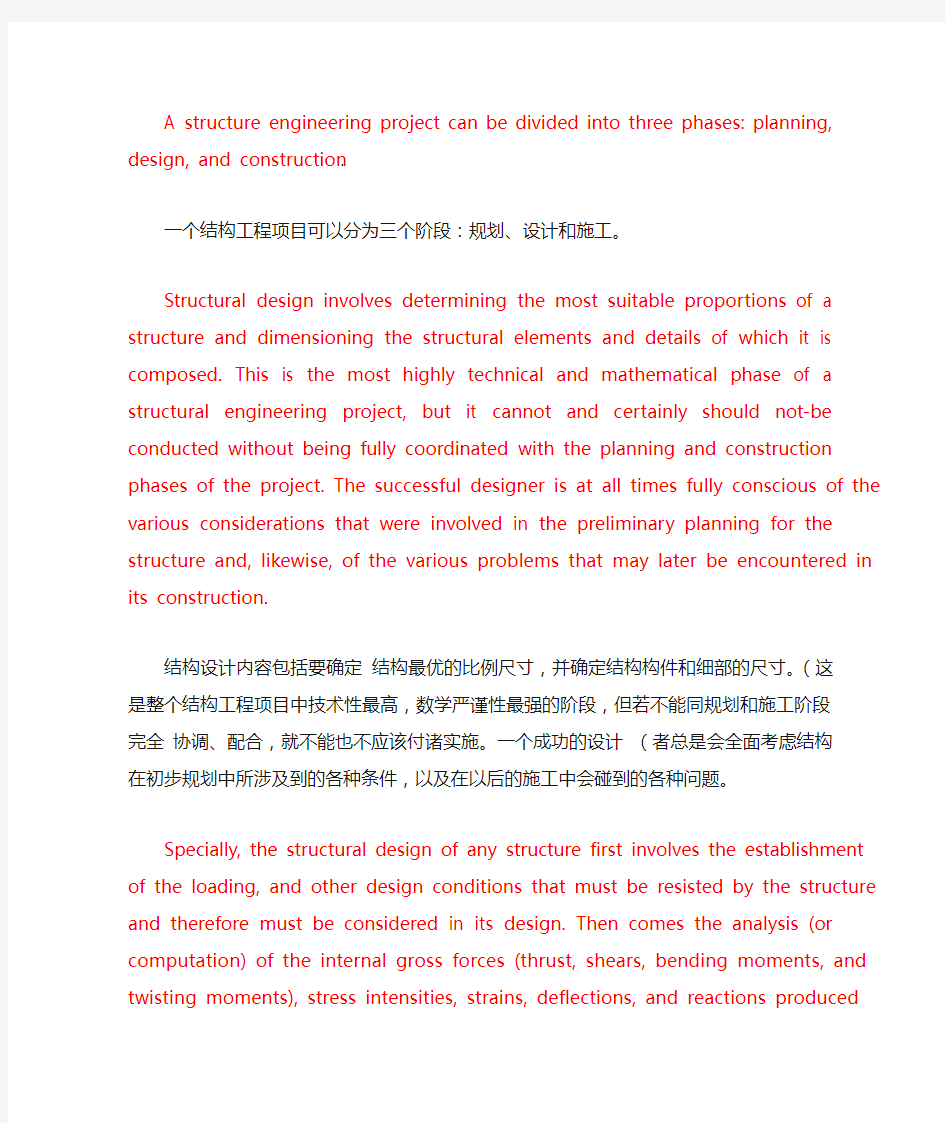5.philosophy of structural design


A structure engineering project can be divided into three phases: planning, design, and construction.
一个结构工程项目可以分为三个阶段:规划、设计和施工。
Structural design involves determining the most suitable proportions of a structure and dimensioning the structural elements and details of which it is composed. This is the most highly technical and mathematical phase of a structural engineering project, but it cannot and certainly should not-be conducted without being fully coordinated with the planning and construction phases of the project. The successful designer is at all times fully conscious of the various considerations that were involved in the preliminary planning for the structure and, likewise, of the various problems that may later be encountered in its construction.
结构设计内容包括要确定结构最优的比例尺寸,并确定结构构件和细部的尺寸。(这是整个结构工程项目中技术性最高,数学严谨性最强的阶段,但若不能同规划和施工阶段完全协调、配合,就不能也不应该付诸实施。一个成功的设计(者总是会全面考虑结构在初步规划中所涉及到的各种条件,以及在以后的施工中会碰到的各种问题。
Specially, the structural design of any structure first involves the establishment of the loading, and other design conditions that must be resisted by the structure and therefore must be considered in its design. Then comes the analysis (or computation) of the internal gross forces (thrust, shears, bending moments, and twisting moments), stress intensities, strains, deflections, and reactions produced by the loads, temperature, shrinkage, creep, or other design conditions. Finally comes the proportioning and selection of materials of the members and connections so as to resist adequately the effects produced by the design conditions. The criteria used to judge whether particular proportions will result in the desired behavior reflect accumulated knowledge (theory, field and model test, and practical experience, intuition, and judgment. For most common civil engineering structures such as bridges and buildings, the usual practice in the past has been to design on the basis of a comparison of allowable stress intensities with those produced by the service loadings and other design conditions.This traditional basis for design is called elastic design because the allowable stress intensities are chosen in accordance with the concept that the stress or strain corresponding to the yield point of the material should not be exceeded at the most highly stressed points of the structure. Of course, the selection of the allowable stresses may also be modified by a consideration of the possibility of failure due to fatigue, buckling, or brittle fracture or by consideration of the permissible deflections of the structure.
在结构设计中,应首先确定结构所必须承受的荷载和其它设计条件,他们是结构设计中的必要条件。然后分析(或者计算)总内力(轴力、剪力、弯矩和扭矩),由荷载、温度、收缩、徐变或者一些其他的设计条件所产生的应力强度、应变、挠曲变形和反力。(最后确定各构件及连接的尺寸并选择其材料,以抵抗设计条件所产生的作用。(当判断某些特殊部位的设计是否符合要求时,就要用到一些经验知识(理论,现场及模型
试验,和实际经验),和直观判别的方法。(由于容许应力在选择时是依据了如下概念:即结构的最大应力或应变不得超过材料屈服应力或应变,因此这种传统的设计原理被称为弹性设计。当然,考虑到由疲劳,弯折,脆裂所引起可能的失败或者结构可允许的挠度,可允许的容许压力的选择也可能被这些影响。
Depending on the type of structure and the conditions involved, the stress intensities computed in the analytical model of the actual structure for the assumed design conditions may or may not be in close agreement with the stress intensities produced in actual structure by the actual conditions to which it is exposed. The degree of correspondence is not important, provided that the computed stress intensities can be interpreted in terms of previous experience. The selection of the service conditions and the allowable stress intensities )provides a margin of safety against failure. The selection of the magnitude of this margin depends on the degree of uncertainty )regarding loading, analysis, design, materials, and construction and on the consequences of failure. For example, if an allowable tensile stress of 20000 psi is selected for structural steel with a yield stress of 33000 psi, the margin of safety (or factor of safety) provided against tensile yielding is 33000/20000. or 1.65.
根据结构类型和所涉及到的条件,采用实际结构的分析模型,在假想的设计条件下计算出的应力强度,和实际结构在实际条件下所产生的应力强度,可能相符也可能不相符。)(只要计算出的应力强度能根据以往的经验来解释,吻合程度就不是很重要。(使用条件和容许应力强度的选择为防止结构失效提供了安全储备。(安全储备大小的选择依赖于相关荷载、分析、设计、材料、施工和失效后果的不确定性程度。(比如:对于结构钢,屈服应力为33000,而容许拉应力为20000,那么为受拉屈服提供的安全储备(安全系数)为33000/20000,或1.65。)
The allowable-stress approach has an important disadvantage in that it does not provide a uniform overload capacity for all parts and all types of structures. As a result, there is today a rapidly )growing tendency to base the design on the ultimate strength and serviceability of the structure, with the older allowable-stress approach serving as an alternative basis for design. The newer approach currently goes under the name of strength design in reinforced-concrete design literature and plastic design in steel-design literature. When proportioning is )done on the strength basis, the anticipated service loading is first multiplied by a suitable load factor (greater than 1), the magnitude of which depends upon the uncertainty of the loading, the possibility of its changing during the life of structure, and, for a combination of loadings,the likelihood, frequency, and duration of the particular combination. In this approach for reinforced-concrete design, the theoretical capacity of a structural element is reduced by a capacity-reduction factor to provide for small adverse variations in material strengths, workmanship, and dimensions.The structure is then proportioned so that, depending on the governing conditions, the increased load would (1) cause a fatigue or a buckling or a brittle fracture failure or (2) just produce yielding at one internal section (or simultaneous yielding at several
section) or (3) cause elastic-plastic displacement of the structure or (4) cause the entire structure to be on the point of collapse.
容许应力法有一个很大的缺点,就是不能对各种类型的结构及其各部分,提供相同的超载能力。(因此,目前更趋向于以结构的极限强度和适用性为基础的设计,这使得以往以容许应力法为基础的设计只能成为可选方案之一。)最新的设计方法在(钢筋混凝土设计文献中被称为强度设计,在钢结构设计文献中被称为塑性设计。(随后,考虑到增大后的荷载将会:①引起疲劳、压曲或脆断破坏;②在某截面发生屈服(或在几个截面上同步屈服);③产生结构的弹塑性位移;④引起整个结构坍塌,所以,根据这些控制条件确定结构尺寸。
Proponents of this latter approach argue that it result in a more realistic design with a more accurately provided margin of strength over the anticipated service conditions. These improvements result from the fact that non-elastic and nonlinear effects (that become significant in the vicinity of ultimate behavior of the structure )can be accounted for.
后一种方法(塑性设计)的倡导者提出,这种方法能够在预期的使用条件下提供更明确的强度储备及更接近实际的设计。)这种方法的进步之处还在于能够计算当结构临近极限状态时,明显的非弹性和非线性效应。
In recent decades, there has been a growing concern among many prominent engineers that not only is the term “factor of safety”improper and unrealistic, but worse still a structural design philosophy based on this concept leads in most cases to an unduly conservative and therefore uneconomical design, and in some cases to an unconservative design with too high a probability of failure. They argue that there is no such thing as certainty, either of failure or of safety of a structure but only a probability of failure or a probability of safety. They feel, therefore, that the variations of the load effects and the variations of structural resistance should be studied in a statistical manner and the probability of survival or the probability of serviceability of a structure estimated. It may not yet be practical to apply this approach to the design of each individual structure. However, it is believed to be practical to do so in framing design rules and regulations. It is highly desirable that building codes and specifications plainly state the factors and corresponding probabilities that they imply.
最近几十年,在许多著名的工程师当中,有一个概念已经越来越明确:那就是不但“安全系数”这个名词本身已不再合适,也不再符合实际,而且更糟糕的是,以此概念为基础的结构设计原理,在许多情况下会导致一个过度保守的,不经济的设计,或在某些情况下产生一个不保守但失效概率很高的设计。他们认为结构的失效和安全都不是确定的事情,(而只存在失效概率和可靠概率。(因此,他们觉得,荷载效应的变异性和结构抗力的变异性应以统计的方式进行研究,然后来估计结构的安全概率和适用性概率。(对任何一个独立结构都采用这种方法还不是很现实,但在制定设计规范时还是很实用的。(最理想的结果是使结构规范明确规定相关系数及其所对应的相应概率。)
